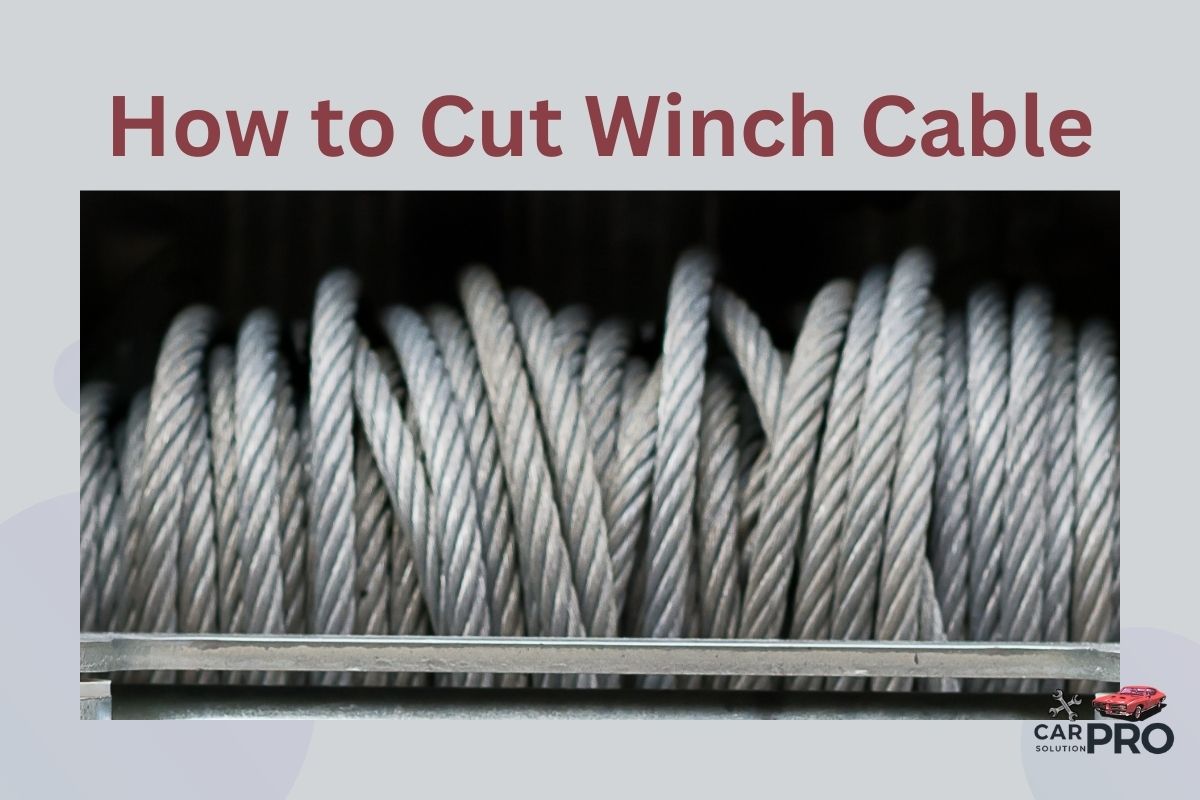Cutting a winch cable may seem like a simple task, but it requires care and precision to do it safely and effectively. Whether you’re replacing an old cable or customizing its length, knowing the proper technique is crucial. To cut winch cable, use specialized wire rope cutters or a hacksaw to carefully sever the cable while taking safety precautions like wearing protective gear.
Many people make the mistake of using standard pliers or bolt cutters, which can lead to frayed ends and weakened cable strength. By following the right steps and using the correct tools, you can achieve a clean cut that maintains the cable’s integrity and prevents unraveling.
This guide will walk you through the process of cutting winch cable, from selecting the right tools to finishing the cut ends. We’ll cover important safety measures and techniques to ensure you get the job done right.
Key Takeaways
- Use proper tools like wire rope cutters or a hacksaw for a clean cut
- Wear safety gear and secure the cable before cutting
- Finish the cut ends to prevent fraying and maintain cable strength
Safety Precautions
Cutting winch cable requires careful attention to safety. Proper protective gear and a secure work area are crucial to prevent injuries and ensure a successful job.
Protective Gear
Safety goggles are essential when cutting winch cable. They protect your eyes from small wire pieces that may fly off during cutting. Wear thick gloves to shield your hands from sharp cable ends and prevent cuts.
A long-sleeved shirt and pants provide skin protection. Steel-toed boots guard against dropped tools or cable sections. Consider using a face shield for extra protection against flying debris.
Hearing protection is important if using power tools to cut the cable. Earplugs or earmuffs can prevent hearing damage from loud cutting noises.
Secure Work Area
Clear the work area of any tripping hazards or obstacles. Ensure you have enough space to move freely while handling the cable. Good lighting is crucial for accurate cutting and spotting potential hazards.
Secure the winch cable to prevent unraveling or sudden movement during cutting. Use clamps or a vise to hold the cable steady. Place a tarp or drop cloth under the cutting area to catch metal shavings and make cleanup easier.
Keep others away from the work area to avoid accidents. Have a first aid kit nearby in case of minor injuries. Ensure proper ventilation if working indoors to disperse any fumes from cutting tools.
Tools and Materials
Cutting winch cable requires specific tools and equipment for accurate, safe results. Proper measuring tools ensure precise cuts, while specialized cutting implements allow clean cable separation without fraying.
Cutting Tools
The right cutting tool is crucial for a clean winch cable cut. Cable cutters designed for steel cables are ideal. These heavy-duty tools have sharp, strong blades that can slice through thick metal strands.
For thinner cables, high-quality bolt cutters may suffice. An angle grinder with an abrasive cutting disc is another effective option. It can quickly cut through cables of various thicknesses.
When using power tools, wear safety gear like goggles and gloves. Always follow the manufacturer’s instructions for proper use and maintenance of cutting tools.
Measuring Equipment
Accurate measurement is key to cutting winch cable to the correct length. A sturdy tape measure is essential. Choose one that’s long enough to measure your full cable length.
A marker or chalk helps mark the cutting point clearly. Some prefer using electrical tape to wrap around the cut point, which can also help prevent fraying.
Cable-specific measuring tools like a cable gauge can determine the exact diameter of your winch cable. This information is important when selecting the appropriate cutting tool.
A workbench or stable surface is necessary for accurate measuring and safe cutting. Ensure you have good lighting to see measurement markings clearly.
Preparation Steps
Getting ready to cut a winch cable requires careful planning and measurement. These steps ensure a clean, safe cut at the right spot.
Measuring the Cable
To measure the winch cable, start by disconnecting it from the winch drum. Lay the cable out straight on a flat surface. Use a tape measure to determine the desired length.
Make sure to account for any attachments or hooks that will be added later. Double-check your measurements to avoid costly mistakes.
Consider the winch’s capacity and your vehicle’s needs when deciding on the final cable length. It’s better to err on the side of caution and leave a little extra length if unsure.
Marking the Cut Point
Once you’ve measured, it’s time to mark the cut point. Use a bright-colored marker or tape that contrasts with the cable color. This makes the cut point easy to see.
Place a piece of masking tape around the cable at the cut point. This helps prevent fraying during cutting. Mark the tape clearly with an arrow pointing to the exact cut location.
For steel cables, wrap electrical tape tightly on both sides of the cut mark. This keeps the cable strands from unraveling. For synthetic rope, use a hot knife to melt the fibers slightly at the mark.
Double-check your measurements and markings before proceeding to cut. A clear, accurate mark ensures a precise cut and saves time in the long run.
Cutting Techniques
Cutting winch cable requires specific methods and tools to ensure safety and precision. The right approach depends on the cable type and available equipment.
Manual Cutting
Manual cutting works well for thinner cables. Use sharp cable cutters designed for winch cables. Position the cable in the center of the cutting jaws. Apply steady pressure to make a clean cut.
For thicker cables, try a hacksaw with a fine-toothed blade. Secure the cable in a vise. Mark the cut point with tape. Saw slowly and evenly to prevent fraying.
Always wear safety glasses and gloves when cutting manually. Wrap the cut area with tape before and after cutting to minimize fraying.
Mechanical Cutting
Power tools speed up the cutting process for thicker cables. An angle grinder with a metal cutting disc works well. Clamp the cable securely. Mark the cut point.
Use steady, even pressure when cutting. Let the tool do the work. Don’t force it. Move slowly to prevent overheating.
A reciprocating saw with a metal-cutting blade is another good option. Choose a fine-toothed blade for smoother cuts. Secure the cable tightly. Cut slowly to avoid blade binding.
Hydraulic Tools
Hydraulic cutters provide the most power for thick winch cables. They use intense pressure to slice through metal strands cleanly.
These tools come in various sizes. Choose one rated for your cable’s diameter. Position the cable in the cutting jaws. Activate the hydraulic pump to close the jaws.
Hydraulic cutters leave a clean edge with minimal fraying. They’re ideal for frequent or high-volume cutting. However, they’re more expensive than other methods.
Always follow the manufacturer’s safety guidelines when using hydraulic tools. Wear protective gear and keep hands clear of moving parts.
Finishing Touches
After cutting your winch cable, a few final steps ensure safety and longevity. These finishing touches protect the cable and prevent fraying or damage during use.
Deburring the Ends
Cut winch cable ends often have sharp edges that need smoothing. Use a metal file to carefully remove any burrs or rough spots. Move the file in one direction along the cable end. Don’t use back-and-forth motions, as this can create more burrs.
For synthetic cables, a lighter can melt frayed ends. Hold the flame near the cut end for a few seconds. This fuses the fibers together, preventing unraveling.
Wear gloves and eye protection during this process. Sharp metal fragments can cause injury. Take your time to achieve a smooth finish that’s safe to handle.
Applying Protective Coatings
Protect the cut cable end from moisture and wear. For steel cables, apply a rust-inhibiting paint or sealant. This prevents corrosion and extends the cable’s lifespan.
Dip the cable end in liquid rubber or use heat-shrink tubing for added protection. These coatings create a barrier against dirt and water. They also provide a smoother surface that’s easier on hands and equipment.
For synthetic cables, use a special end cap or whipping twine. This keeps the cable from fraying over time. Secure the cap or twine tightly to prevent it from coming loose during use.
Always follow the manufacturer’s recommendations for your specific cable type. Different materials may require unique protective measures.
Frequently Asked Questions
Cutting winch cable requires specific tools and techniques to ensure safety and effectiveness. The right approach depends on the cable material and available equipment.
What is the safest method to cut winch cable to length?
The safest method to cut winch cable is using a cable cutter designed for winch cables. These tools provide a clean cut without fraying. Always wear safety glasses and gloves when cutting cable.
Which tool should I use for cutting through stainless steel wire rope?
For stainless steel wire rope, a high-quality cutting wheel or hydraulic cable cutter works best. These tools can handle the hardness of stainless steel without damaging the cable structure.
Can synthetic winch rope be cut, and if so, how?
Yes, synthetic winch rope can be cut. Use a sharp knife or razor blade to carefully slice through the rope. Heat-sealing the cut ends prevents fraying.
What procedures are recommended when using an angle grinder to cut winch cable?
When using an angle grinder, secure the cable to prevent movement. Use a metal-cutting disc and cut slowly to avoid overheating. Wear full protective gear, including a face shield.
How can I cut metal cable cleanly without fraying?
To cut metal cable cleanly, wrap tape around the cutting point. Use a sharp cable cutter or cutting wheel. Cut in one swift motion to minimize fraying.
Is there a way to cut through 3mm steel wire without wire cutters?
Alternative methods for cutting 3mm steel wire include using a hacksaw with a fine-toothed blade or a reciprocating saw with a metal-cutting blade. Secure the wire firmly before cutting.


